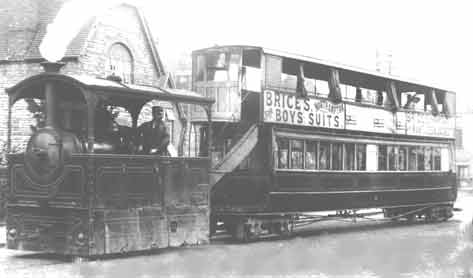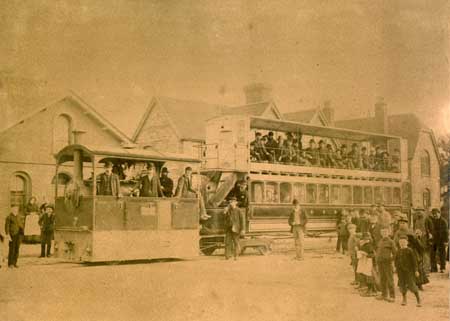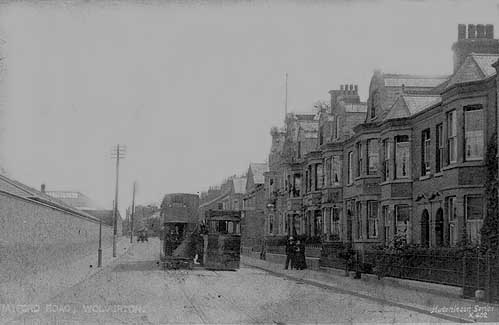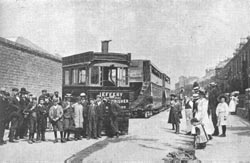![]()
The contents on this page remain on our website for informational purposes only.
Content on this page will not be reviewed or updated.
![]()
The contents on this page remain on our website for informational purposes only.
Content on this page will not be reviewed or updated.

THE STORY OF THE TRAM
The early days 1882 - 1887
Our story begins over a hundred years ago in the railway town of Wolverton. The LNWR were expanding the railway works in the town and Messrs McCorquodales were establishing their new printing works nearby. Every day hundreds of workmen walked and cycled between Stony Stratford and Wolverton, because the only alternative was a horse drawn bus which cost 6d for a single journey - a lot of money when you consider that the average wage was 30shillings a week in 1882.

An enterprising group of Stony Stratford tradesman put forward a proposal to link the two towns by means of a light railway. In 1883 a Tramways Order was granted to a Frederick Charles Winby to build a line 2 miles 54 chains long between Wolverton Station and the northern end of the High Street Stony Stratford. However the project remained dormant until in 1886 Charles Herbert Wilkinson of Wilkinson and Company took over the project. He contracted to build the line for £13,325 and under an indenture accepted £2000 in shares. The line was built to 3feet 6 inches gauge rather the 4 feet gauge originally authorised.
On to Deanshanger 1888
With an eye to goods traffic Wilkinson promoted an extension to the tramway from the High Street Stony Stratford to a point near the Fox and Hounds Public House on the green at Deanshanger, a distance of 2 miles 3 chains. Deanshanger had been the home of E.& H.Roberts implement manufacturers since 1820.

The first section across the River Ouse was built quickly and opened in 1887 and the major portion of the extension was completed by May12th 1888 and was sanctioned by the Board of Trade on May24th 1888. The fare from Wolverton to Deanshanger was 4d.
A year later the company ran into financial difficulties and was declared insolvent, and the line closed. The original part of the tram track between Wolverton and Stony Stratford was taken over in 1891 by a Bedford Syndicate, but the extension never reopened and the track was taken up. The rails were used as edging to the asphalt on Market Square Stony Stratford
The Bedford Syndicate 1891- 1919
The Bedford Syndicate was headed by Herbert Samuel Leon afterwards knighted as Sir Herbert, and traded under the name of Wolverton & Stony Stratford & District Tramways Company - quite a mouthful for such a short line. This syndicate reopened the line on November 20th 1891. Gradually the shares were transferred to Sir Herbert Leon until he held a controlling interest, but members of the Field family who were also associated with him in the purchase retained their holdings and Alfred Long Field was Managing Director and Secretary of the Company until his death in 1913.

Sir Herbert Leon
The enterprise proved highly successful and an additional engine was ordered from the Falcon Works Loughborough in 1900. By 1906 the rails were in a bad state of repair and were the cause of several minor accidents to cyclists and motorcyclists, Bucks County Council were forced to take proceedings against the Tramway Company under the Tramway Act of 1870. After considerable deliberation work started on repairing and altering the position of the line to take account of the sudden increase in automobile traffic.

The steam tram has long since had its day and its life was short even within the history of tramways. They flourished only for about 20 years from 1881 to 1901 and few undertakings survived the first few years of the present century, but here and there the odd rural system survived until the early 1920's. The last passenger carrying steam tramway in England was our own Wolverton to Stony Stratford tramway - affectionately known as 'Our Tram'.
Off the rails - A chapter of accidents
Many accidents occurred on the tramway throughout its history. Here are the details of one such as reported in a local newspaper.

'A number of soldiers and some contractors men got on the tram on Saturday night and the tram being crowded and boys being boys one or two climbed on to the roof of the tram. Things went on quietly until Mill Drive was reached when one of the men pitched off. With some difficulty the tram was stopped and a number of the male passengers started back along the road to find his body, fully expecting to find him half dead. However although he was severely bruised, no bones had been broken and the incident terminated with a good deal of grumbling from the conductor and a joke in the camp?'.
Between the towns
The harsh weather during the winter of 1906 caused numerous delays to the repair work and further confrontation between the navvies working on the project, and the local Councils did not aid progress. For several months the tram did not run at all, and passengers were transported in a range of conveyances provided by the Bull Hotel, Stony Stratford. The work was eventually completed in July 1907 to the relief of the weary railway workers who had been forced 'to trudge to their daily toil'.
By 1915 the line was again running into financial difficulties. An increase in fares only provided a temporary stay of execution and at the end of the First World War the line faced closure. Immediately a committee of five workmen was appointed in an endeavour to continue the tramway service. Sir Herbert Leon and the Board of Trade eventually agreed that a workmen's service should be provided, but that normal passengers services were curtailed.